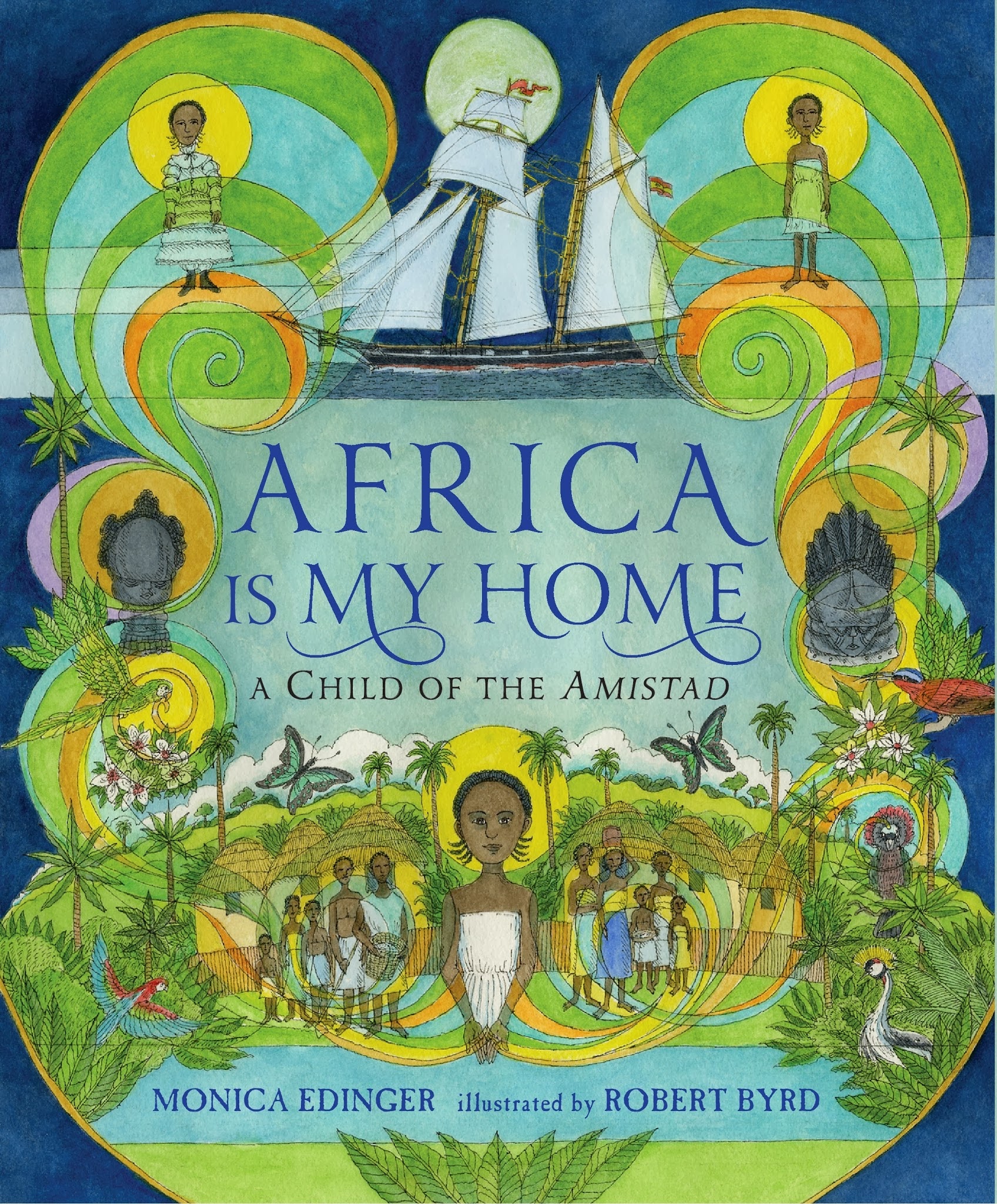09 Jun / Africa Is My Home: A Child of the Amistad by Monica Edinger, illustrated by Robert Byrd

 In what should have been a year-long contract of difficult labor as a “pawn” for a 9-year-old girl whose family cannot survive otherwise, becomes a horrific journey to the other side of the world. Named Magulu by her parents, she becomes Margru because of a mishearing when she arrives in the West; historically, she’ll be known as Sarah Margru Kinson, one of four children on the legendary Amistad. Educator Monica Edinger, after “try[ing] for years to write it as nonfiction,” eventually reclaims Margru story as a middle-grade biographical novel. “The story is still true,” she explains in her “Author’s Note.” “[T]hose instances where I have imagined her feelings, invented dialogue, or created scene are based on my research and on firsthand experiences in Sierra Leone.”
In what should have been a year-long contract of difficult labor as a “pawn” for a 9-year-old girl whose family cannot survive otherwise, becomes a horrific journey to the other side of the world. Named Magulu by her parents, she becomes Margru because of a mishearing when she arrives in the West; historically, she’ll be known as Sarah Margru Kinson, one of four children on the legendary Amistad. Educator Monica Edinger, after “try[ing] for years to write it as nonfiction,” eventually reclaims Margru story as a middle-grade biographical novel. “The story is still true,” she explains in her “Author’s Note.” “[T]hose instances where I have imagined her feelings, invented dialogue, or created scene are based on my research and on firsthand experiences in Sierra Leone.”
As a pawn, Magulu was stolen from her native Mendeland in West Africa, and herded onto a ship for “Seven weeks in a dark and airless hold … Seven weeks of chains and shackles … Seven weeks of pain and suffering.” She landed in Cuba, and was bought with a boy and two other girls by a white man. The children then boarded the Amistad with other African captives. One of the men, later known as Cinque, led a violent but successful revolt, claimed control of the ship, and demanded to sail back to Africa.
The ship instead did more zigzagging along the East Coast until it was captured, landing the Africans in a New Haven jail facing charges of mutiny and murder. At least in Connecticut, slavery was illegal. Margru and the other girls were taken in by the jailer’s wife, with whom they stayed through multiple trials, surprisingly able to even attend school. The final trial went to the Supreme Court, and was argued by former president John Quincy Adams in favor of freedom for the Africans.
Margru’s story doesn’t end there (you’ll have to read the rest yourself), which Edinger carefully reconstructs from some of Margru’s own letters. Her inspiring narrative is enhanced by award-winning illustrator Robert Byrd, who “present[s] the diverse historical scenes as accurately as possible – people, costumes, ships, buildings, and settings,” as he explains in his back flap bio. Mixed in with Byrd’s richly detailed drawings, are historical images and documents, including a “slave barracoon” in which captives were trapped on African shores, newspaper renderings and articles, and even a pencil sketch of Margru (labeled “Marqu”).
While the Amistad revolt has had various incarnations – from a play written and produced as early as 1839 (!), Long Low Black Schooner, to the 1997 Steven Spielberg controversial celluloid extravaganza, Amistad – Edinger’s Africa seems to be the first title for younger readers to highlight the life of an Amistad child. [Additionally, a 2003 18-page booklet, Sarah Margru Kinson: The Two Worlds of an Amistad Captive, is available from the Oberlin Heritage Center.] Fictionalized though Africa might be, the spirit of Margru’s story – the love of freedom, reasons to hope, the longing to return home – are universal, timeless truths Edinger faithfully embodies here.
Tidbits: Next month – July – marks the 175th anniversary of “The Amistad Incident of 1839.” A replica of the vessel, launched in 2000, begins its summer tour on July 3, sharing history and teaching justice. For older readers, Lawrence Hill’s 2007 stupendously award-winning historical novel, Someone Knows My Name (also published as The Book of Negroes and Aminata), makes for a perfect companion text, about an 11-year-old African girl’s abduction, her decades of captivity, and her eventual return to her homeland. The novel is currently in production to become a mini-series.
Readers: Middle Grade
Published: 2013
